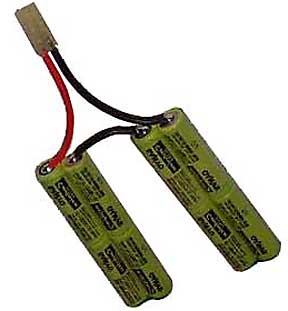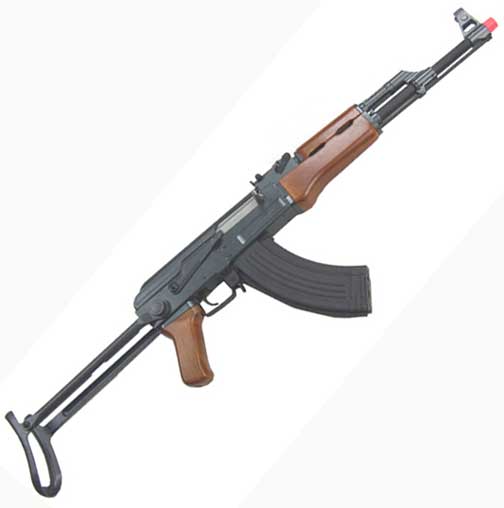*Offer expires 04/30/24 at 3 a.m. ET. Some exclusions apply.
*Offer expires 04/30/24 at 3 a.m. ET. Some exclusions apply.
by Tom Gaylord
Copyright PyramydAir.com ©2008. All Rights Reserved.
Airsoft guns have one of three powerplants - spring-piston, gas or automatic electric (abbreviated AEG, for automatic electric gun). An AEG is a spring-piston gun with a small motor that cocks the piston automatically. The gun has select-fire, which means it will fire both semiautomatically (one shot with each pull of the trigger) or fully automatic (gun fires when trigger is pulled and doesn't stop until trigger is released).
That small motor needs electric power, which it draws from a battery of some type stored out of sight on the gun. Inexpensive AEGs operate on common AA batteries. When the guns become more sophisticated, they use rechargable batteries.
Many AEGs that use rechargable batteries come with one battery pack and a charger, so the gun is complete. As the guns go up in price, however, sometimes they don't come with batteries, because owners may have very specific battery requirements and may wish to purchase the batteries separately. The guns are also less expensive if they don't include batteries and a charger.
Battery configurations (shapes)
Rechargable batteries are packaged in several different shapes, and an AEG may only have room for one shape, so it is important to know which shape your gun uses. When the individual cells are arranged in two columns, sometimes with one cell at the bottom of one single pack, they're commonly called "large" batteries. Don't use that as a buying guide! There is no standard for the term large, so you have to find out if the battery will fit your gun.

The large battery is most often used in the butts of large rifles, where there's a lot of room for storage. This type of rifle is the easiest to upgrade to larger batteries.

The large, hollow buttstock of the M16 has room for larger batteries.
Sometimes, the batteries come in two separate columns connected by wire. These are called nunchuk batteries, because of their resemblance to the martial arts weapon. They're commonly used when the batteries are stuffed inside the forearm of the AEG on either side of the barrel, such as inside the hollow forearm of an M4 carbine.

The nunchuck-style battery is split into two sections, joined by wire. It's most often stuffed on either side of the barrel inside a round handguard on an M4 carbine or similar-sized AEG.

The M4's collapsible butt has no room for a battery, so the round handguard houses a nunchuck-type battery.
Other batteries have cells arranged in one long stick, hence the name stick battery. These also have specific models of guns they fit.

A stick battery looks just like it sounds. Most often used in the handguards of AK47s with folding stocks.

The folding stock has no room for the battery, so this AK47 hides a stick battery in the forearm.
When an AEG has very little space for the battery, you may have to use one constructed with smaller cells. A "small" battery will have the correct voltage for your gun, but will be limited on the amount of electricity, stated as milliamp hours (or mAH). Let's look at mAH ratings next.
Battery specifications - mAH rating
Two battery terms you need to learn are mAH rating and voltage. Let's start with the mAH rating. The mAH rating tells you how much power the battery holds - similar to how many gallons of gas a car's tank holds. Since your AEG uses electricity at a constant rate (more or less), the higher the mAH rating, the longer you can operate before needing to recharge. However, the higher the mAH rating, the larger the battery will be, and your gun will have size constraints. Also, the higher the mAH rating, the more the battery tends to cost, though there are several other factors that drive the cost. The higher the mAH rating, the longer it takes to fully charge a battery, given a constant charge rate. We'll discuss the charge rate in a bit.
You'll find batteries with mAH ratings from a low of 600 mAH to a high of 3000 mAH. Remember, the battery must fit into your battery box, so don't just select one based on capacity, alone. Remember that capacity and voltage are independent of each other.
Battery specifications - voltage
The voltage of a battery determines the rate at which the power flows out of the battery. An 8.4-volt battery will run a certain motor at a given speed. A 9.6-volt battery will run the same motor faster, or, if the motor encounters a load that slows it, the 9.6-volt battery will slow down less than the 8.4-volt battery running the same motor. Think of the voltage as the horsepower of the battery.
So, if you have an AEG M4 carbine with a cyclic rate (number of rounds per minute the gun fires when in the full-auto mode) of 750 rounds per minute, a 9.6-volt battery might boost that RPM up to 850 or even 900. Sounds great, doesn't it? There's one big drawback. If your gun's gearbox is not rated to operate for sustained periods above 800 RPM, running it at 850 could break it in just a few minutes.
Higher-voltage batteries are for when guns have been upgraded with stronger gearboxes and more powerful mainsprings. Using them on an unmodified gun is risking damage to the gun.
The standard voltages available today are 8.4, 9.6 and 10.8. For super-modified guns with very strong gearboxes and heavy-duty powerplants, there's a 12-volt battery that's the highest in general use. Umarex offers some small airsoft guns that have proprietary 7.2-volt batteries.
Battery specifications - technology
What the battery is made of plays a huge part in how it works. Not so much in the kind of power it delivers, but in the number of charge cycles and the speed of the charge cycle.
Nickel cadmium
Years ago, the nickel cadmium (NiCd or NiCad, pronounced Nye Cad) battery was king, only because it was about the only rechargeable battery there was. This is the type of battery that many claim has a memory and will gradually take less and less of a charge until it no longer works. When you use them, you should discharge the battery all the way to nothing or you may lose a portion of its storage capacity, especially in AEGs. NiCd batteries charge very quickly; however, they generate heat when charging and must not be charged faster than recommended or they can explode. NiCd batteries discharge at the rate of 10-20 percent a month when not used.
Nickel metal hydride
Nickel metal hydride (NiMH) batteries have less of a memory than NiCd and can be topped off without ruining their capacity for storage. They hold more of a charge than NiCd batteries of equal size and their self-discharge rate is lower. They will therefore have greater voltage and more capacity for a given size. They cannot be charged over a certain rate per hour and take longer than NiCd batteries to recharge. They cost a little more than NiCd batteries.
Lithium-ion
Lithium-ion (Li-ion) batteries hold their charge for a very long time. They also recharge very quickly. They do not suffer from memory at all. They are not as durable as NiCd or NiMH batteries, and they suffer capacity loss from age, alone, which the other types do not.
Buy With Confidence
Get FREE shipping on qualifying orders! Any order $150+ with a shipping address in the contiguous US will receive the option for free ground shipping on items sold & shipped by Pyramyd AIR during checkout. Certain restrictions apply.
Free shipping may not be combined with a coupon unless stated otherwise.
View Shipping Info
We work hard to get all orders placed by 12 pm EST out the door within 24 hours on weekdays
because we know how excited you are to receive your order.
Weekends and holiday shipping times will vary.
During busy holidays, we step our efforts to ship all orders as fast as possible,
but you may experience an additional 1-2 day delay before your order ships.
This may also happen if you change your order during processing.
View Shipping Times
It's important to know that due to state and local laws, there are certain restrictions for various products.
It's up to you to research and comply with the laws in your state, county, and city.
If you live in a state or city where air guns are treated as firearms you may be able to take advantage of our FFL special program.
U.S. federal law requires that all airsoft guns are sold with a 1/4-inch blaze orange muzzle
or an orange flash hider to avoid the guns being mistaken for firearms.
View Shipping Restrictions
Get the most out of your equipment when you work with the expert technicians at Pyramyd AIR. With over 25 years of combined experience, we offer a range of comprehensive in-house services tailored to kickstart your next adventure.
If you're picking up a new air gun, our team can test and tune the equipment before it leaves the warehouse. We can even set up an optic or other equipment so you can get out shooting without the hassle. For bowhunters, our certified master bow technicians provide services such as assembly, optics zeroing, and full equipment setup, which can maximize the potential of your purchase.
By leveraging our expertise and precision, we ensure that your equipment is finely tuned to meet your specific needs and get you ready for your outdoor pursuits. So look out for our services when shopping for something new, and let our experts help you get the most from your outdoor adventures.
View Service Info
Shop and purchase with confidence knowing that all of our air guns (except airsoft) are protected
by a minimum 1-year manufacturer's warranty from the date of purchase unless otherwise noted on the product page.
A warranty is provided by each manufacturer to ensure that your product is free of defect in both materials and workmanship.
View Warranty Details
Didn't get what you wanted or have a problem? We understand that sometimes things aren't right and our team is serious about resolving these issues quickly. We can often help you fix small to medium issues over the phone or email.
If you need to return an item please read our return policy.
Learn About Returns
Get FREE shipping on qualifying orders! Any order $150+ with a shipping address in the contiguous US will receive the option for free ground shipping on items sold & shipped by Pyramyd AIR during checkout. Certain restrictions apply.
Free shipping may not be combined with a coupon unless stated otherwise.
View Shipping Info
Want More?
Join Our Email List for News and Deals!
Join the Pyramyd AIR mailing list: Our e-mails are filled with new products, deals, sneak peeks, tips and tricks, contests and more - sign up today!
Text JOIN to 91256 and get $10 OFF Your Next $50+ Order!
* By providing your number above, you agree to receive recurring autodialed marketing text msgs (e.g. cart reminders) to the mobile number used at opt-in from Pyramyd AIR on 91256. Reply with birthday MM/DD/YYYY to verify legal age of 18+ in order to receive texts. Consent is not a condition of purchase. Msg frequency may vary. Msg & data rates may apply. Reply HELP for help and STOP to cancel. See Terms and Conditions & Privacy Policy.